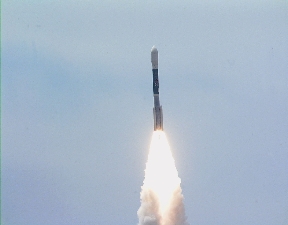

Mission Status Report #10 Star Date: July 15, 1999 Mission Status Reports on the web page will occur whenever news-worthy events occur (but at least weekly!) for the time being.
(Click photo to see larger version.) See more Launch Day Photos.
FUSE CHECKOUT BACK ON TRACK
The FUSE satellite remains healthy and the In-Orbit Checkout phase is still in progress. The Satellite Control Center at JHU is routinely in contact with the spacecraft through the Puerto Rico and Hawaii ground stations, and occasionally through TDRSS contacts. Thermal control has been thoroughly tested, with the spectrograph ready for "bake-out" mode prior to reducing temperatures as we approach normal operations. Since the last report, significant progress has been made in understanding the problems discussed in last week's report, and we are now moving forward carefully with the In-Orbit Checkout (IOC) timeline of activities. Several more radiation-induced events have been observed, but updated onboard monitoring and management techniques have prevented any new problems. The Attitude Control situation is now well understood, and we have had a full week of nominal pointing operations, with (hopefully) many more to come! Just last evening (Wednesday 7/14/99), the first telescope baffle door was opened. In a report to the FUSE Science Team, Bill Oegerle reports on the scene:
Last night at about 8:55 pm EDT, we successfully opened the LiF1 baffle
door. The crowd in the SCC cheered as the opening HOP (paraffin actuator)
heated up from -37 degrees to nearly +50 degrees, and the door sprang open.
This will assist the telescope in outgassing (releasing any trapped gases into space) and allow a first assessment of the Fine Error Sensor (CCD Guide Camera) performance in imaging actual star fields on the sky! More as soon as it becomes available. Over the next week, we hope to see "first light" with the FES Guide Camera, to perform tests demonstrating actual tracking and guiding capability, and to open the remaining baffle doors in preparation for beginning the focus and alignment of the telescopes. It will be several more weeks before we expect to see the first science data from the far-ultraviolet spectrograph detectors. Reported by: Bill Blair, Chief of Mission Planning
|
